There are 4 key features which matter in business: : fluency, flexibility, visibility and forecasting. Those features are most wanted by business leaders while selecting and implementing software supporting various teams’ work. Every system, whether for HR, Finance or Sales should:
- be so flexible to answer the needs of the companies which do not operate in a standard way
- provide data flow
- be transparent
- be able to analyze the data
The answer to those needs, except the system itself, will be integrations. According to The Deloitte Global Chief Procurement Officer Survey 2017 42% of CPOs say that lack of data integration is one of the main barriers to the effective application of digital. Actually we should underline that this is not about the system integration itself, but rather data integration. Since it does not really matter what systems we are integrating, but what kind of data.
Source: The Deloitte Global CPO Survey 2017
Most often asked questions by customers are: “Have you integrated your system with SAP?”, or “Have you integrated the system with iScala?”. The right question should be:
“ Does your system would support integrating data x with data y?”
Then we may be sure whether the requirements we have may be met or not.
We have decided to take advantage of our experience in working with many procurement teams and present the 5 hottest integrations with procurement systems.
- ERP system integrations.
Meaning exporting orders from procurement software to the ERP system (for example SAP). Supplier and order data export is something what the customers expect most often.
- Supplier database and business investigations
Some of our customers verify supplier reliability using various sources. They need to have all updated news on suppliers in one integrated place, so to manage them, basing on the available data in a procurement system.
- Integration with PunchOut catalogues.
The aim of such integration is to upload products from the catalogue to the purchase request (and undergo internal acceptance workflow), monitor all company expenses in a procurement system (not in a supplier system). Very often there is an additional integration required, so exporting the accepted order to a supplier (by email or an interface with the supplier system).
- Active Directory integration
The objective is to simplify login process. After such integration the system will recognize a user without additional authorization.
- Integration with the organizational structure of the company. The interface which enables to update users’ structure and permissions automatically.
System integrations have become the glue to cement overall business strategies, mostly based on big data analysis (read more on big data in procurement read here: Big Data in Procurement. Revolution or evolution?). For employees integrations serve as a bridge to greater accessibility into information, hence to effective data use. We need to realize that procurement software is crucial for a company, but it’s not a strategy steering mechanism, but it’s its element. To make integration successful (for example with HR or Finance tools) we need to define contact points. Then system implementation with its integrations will have real impact of a company functioning.
Good luck!
P.S. NextBuy may integrate with all the 5 solutions. Thanks to that it supports digitalization effectively.
If you want to check how NextBuy can support you, request NextBuy demo with one of our procurement experts.




